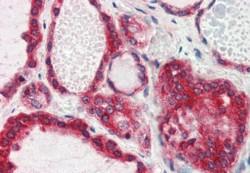Goat Anti-Lipin 3 Antibody
Peptide-affinity purified goat antibody
- SPECIFICATION
- CITATIONS
- PROTOCOLS
- BACKGROUND

Application
| IHC, E |
|---|---|
| Primary Accession | Q9BQK8 |
| Other Accession | NP_075047, 64900 |
| Reactivity | Human |
| Host | Goat |
| Clonality | Polyclonal |
| Concentration | 100ug/200ul |
| Isotype | IgG |
| Calculated MW | 93614 Da |
| Gene ID | 64900 |
|---|---|
| Other Names | Phosphatidate phosphatase LPIN3, 3.1.3.4, Lipin-3, Lipin-3-like, LPIN3, LIPN3L |
| Format | 0.5 mg IgG/ml in Tris saline (20mM Tris pH7.3, 150mM NaCl), 0.02% sodium azide, with 0.5% bovine serum albumin |
| Storage | Maintain refrigerated at 2-8°C for up to 6 months. For long term storage store at -20°C in small aliquots to prevent freeze-thaw cycles. |
| Precautions | Goat Anti-Lipin 3 Antibody is for research use only and not for use in diagnostic or therapeutic procedures. |
| Name | LPIN3 (HGNC:14451) |
|---|---|
| Synonyms | LIPN3L |
| Function | Magnesium-dependent phosphatidate phosphatase enzyme which catalyzes the conversion of phosphatidic acid to diacylglycerol during triglyceride, phosphatidylcholine and phosphatidylethanolamine biosynthesis therefore regulates fatty acid metabolism. |
| Cellular Location | Nucleus. |
| Tissue Location | Significant expression in intestine and other regions of the gastrointestinal tract. |

Thousands of laboratories across the world have published research that depended on the performance of antibodies from Abcepta to advance their research. Check out links to articles that cite our products in major peer-reviewed journals, organized by research category.
info@abcepta.com, and receive a free "I Love Antibodies" mug.
Provided below are standard protocols that you may find useful for product applications.
Background
Humans lipodystrophy is characterized by loss of body fat, fatty liver, hypertriglyceridemia, and insulin resistance. Mice carrying mutations in the fatty liver dystrophy (fld) gene have similar phenotypes. Through positional cloning, the mouse gene responsible for fatty liver dystrophy was isolated and designated Lpin1. The nuclear protein encoded by Lpin1 was named lipin. Lpin1 mRNA was expressed at high levels in adipose tissue and was induced during differentiation of preadipocytes. These results indicated that lipin is required for normal adipose tissue development and provided a candidate gene for human lipodystrophy. Through database searches, mouse and human EST and genomic sequences with similarities to Lpin1 were identified. These included two related mouse genes (Lpin2 and Lpin3) and three human homologs (LPIN1, LPIN2, and LPIN3). Human LPIN1 gene has been mapped to 2p25.; linkages of fat mass and serum leptin levels to this same region have been noted. Human LPIN2 and LPIN3 mapped to chromosomes 18p11 and 20q11-q12, respectively. The mouse genes encoding Lpin1, Lpin2, and Lpin3 mapped to chromosome 12, 17, and 2, respectively.
References
Generation and initial analysis of more than 15,000 full-length human and mouse cDNA sequences. Strausberg RL, et al. Proc Natl Acad Sci U S A, 2002 Dec 24. PMID 12477932.
The DNA sequence and comparative analysis of human chromosome 20. Deloukas P, et al. Nature, 2001 Dec 20-27. PMID 11780052.
Lipodystrophy in the fld mouse results from mutation of a new gene encoding a nuclear protein, lipin. P茅terfy M, et al. Nat Genet, 2001 Jan. PMID 11138012.
Adipose tissue deficiency, glucose intolerance, and increased atherosclerosis result from mutation in the mouse fatty liver dystrophy (fld) gene. Reue K, et al. J Lipid Res, 2000 Jul. PMID 10884287.
If you have used an Abcepta product and would like to share how it has performed, please click on the "Submit Review" button and provide the requested information. Our staff will examine and post your review and contact you if needed.
If you have any additional inquiries please email technical services at tech@abcepta.com.













 Foundational characteristics of cancer include proliferation, angiogenesis, migration, evasion of apoptosis, and cellular immortality. Find key markers for these cellular processes and antibodies to detect them.
Foundational characteristics of cancer include proliferation, angiogenesis, migration, evasion of apoptosis, and cellular immortality. Find key markers for these cellular processes and antibodies to detect them. The SUMOplot™ Analysis Program predicts and scores sumoylation sites in your protein. SUMOylation is a post-translational modification involved in various cellular processes, such as nuclear-cytosolic transport, transcriptional regulation, apoptosis, protein stability, response to stress, and progression through the cell cycle.
The SUMOplot™ Analysis Program predicts and scores sumoylation sites in your protein. SUMOylation is a post-translational modification involved in various cellular processes, such as nuclear-cytosolic transport, transcriptional regulation, apoptosis, protein stability, response to stress, and progression through the cell cycle. The Autophagy Receptor Motif Plotter predicts and scores autophagy receptor binding sites in your protein. Identifying proteins connected to this pathway is critical to understanding the role of autophagy in physiological as well as pathological processes such as development, differentiation, neurodegenerative diseases, stress, infection, and cancer.
The Autophagy Receptor Motif Plotter predicts and scores autophagy receptor binding sites in your protein. Identifying proteins connected to this pathway is critical to understanding the role of autophagy in physiological as well as pathological processes such as development, differentiation, neurodegenerative diseases, stress, infection, and cancer.


